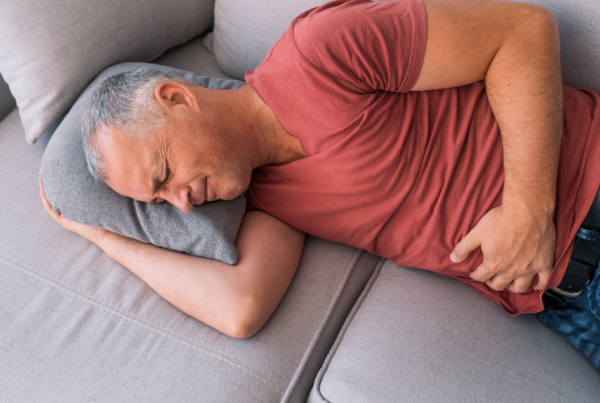Endometriosis
Move Better. Live Fuller. Your Wellness Journey Starts Here.
Schedule a FREE Discovery Call!
What Is Endometriosis?
Endometriosis is a chronic condition where tissue similar to the inner lining of the uterus (the endometrium) grows outside of the uterus where it is not supposed to be, such as on the ovaries, fallopian tubes, and other areas of the pelvis.
This lining acts similarly to the lining inside the uterus, regularly thickening, breaking down, and bleeding with each menstruation—which can cause extreme pain before, during, or after a period.
This pain is often felt in the abdomen, lower back, and pelvic region. Endometriosis can also cause pain with sexual intercourse, bowel movements, and urination. Unfortunately, endometriosis has other symptoms such as:

- Creation of cysts (called endometriomas) on the ovaries
- Creation of adhesions, which cause organs to stick together
- Worsened symptoms of other conditions such as IBD
- Creation of scar tissue
- Struggles with fertility
- Heavier periods
- Constipation or diarrhea
- Pelvic pain
- Bloating and nausea
- Fatigue
What Causes Endometriosis?
The cause of endometriosis is unknown, and there is no way to prevent or cure it. Some individuals may find that their symptoms lessen with menopause, but this is not necessarily true for all cases. Therefore, those with endometriosis seek out ways to better manage their symptoms.
Earlier diagnosis can reduce the likelihood of long-term symptoms and reduce the progression of the disease. Although there is no officially determined cause of endometriosis, there are some factors that may put some individuals at higher risk of having the condition, including:
- Having heavier periods
- Starting their period at an early age
- Having a shorter menstrual cycle
- Having a family history of endometriosis
Physical Therapy for Endometriosis
Finding relief from endometriosis can be a different journey for each person. Symptoms and pain vary from person to person, and what works for one person may not work for the next. For many individuals, pelvic floor physical therapy can be an effective way to manage endometriosis symptoms.
Your pelvic floor is a group of muscles in the pelvic region that support your uterus, bladder, bowels, and other important organs. It allows for body stability, and lets you perform important functions such as bowel movements, urination, or sexual activities. Pelvic floor physical therapists are pelvic health experts and can help you better manage a variety of symptoms experienced with endometriosis.
Often with endometriosis, individuals may have an unintentional tightening of their pelvic muscles in response to the intense pain they may feel each month. These tight muscles can worsen your symptoms and create pelvic floor dysfunction. This dysfunction can lead to issues with bowel movements, sexual appreciation, pain, and more. Pelvic floor therapists can relieve this tightness through a variety of treatments such as relaxation techniques, biofeedback, manual therapy, and more.
In general, endometriosis causes more than just the abdominal pain many are familiar with during their period. It can also cause lower back, pelvic, and other bodily pains which can be addressed with a variety of physical therapy treatments—manual therapy, electric stimulation, cupping, and others.
Additionally, many symptoms can be better addressed by improving the overall health of the body—not just the pelvic region. Incorporating exercise, stretching, and strengthening to improve your body’s flexibility and mobility can lessen the effects of muscle tightness, body pains, and many other endometriosis symptoms. Luckily, physical therapists are very knowledgeable about the body and can create a curated exercise plan just for you!
Seeing a pelvic floor physical therapist is good for education, too. They are very experienced with pelvic health and conditions such as endometriosis. Therefore, they can answer your questions about your body or your condition, and teach you stretches, exercises, breathing techniques, or massage methods that you can use at home to manage your symptoms. If you’d like to learn more and see if physical therapy can be a good fit for you and your endometriosis symptoms, get started with a discovery call!
When working with a physical therapist at Hive to better manage endometriosis, you may experience any of the following treatment methods:
- Neuromuscular re-education
- Manual therapy
- Exercise prescription
- Dry needling
- Cupping
- Tissue scraping
- Behavioral modifications
- Therapeutic activities
- Electrical muscle stimulation
- Spinal manipulation
- Therapeutic modalities
- Biofeedback
Endometriosis is a chronic condition where tissue similar to the inner lining of the uterus (the endometrium) grows outside of the uterus where it is not supposed to be, such as on the ovaries, fallopian tubes, and other areas of the pelvis.
This lining acts similarly to the lining inside the uterus, regularly thickening, breaking down, and bleeding with each menstruation—which can cause extreme pain before, during, or after a period.
This pain is often felt in the abdomen, lower back, and pelvic region. Endometriosis can also cause pain with sexual intercourse, bowel movements, and urination. Unfortunately, endometriosis has other symptoms such as:
- Creation of cysts (called endometriomas) on the ovaries
- Creation of adhesions, which cause organs to stick together
- Worsened symptoms of other conditions such as IBD
- Creation of scar tissue
- Struggles with fertility
- Heavier periods
- Constipation or diarrhea
- Pelvic pain
- Bloating and nausea
- Fatigue
The cause of endometriosis is unknown, and there is no way to prevent or cure it. Some individuals may find that their symptoms lessen with menopause, but this is not necessarily true for all cases. Therefore, those with endometriosis seek out ways to better manage their symptoms.
Earlier diagnosis can reduce the likelihood of long-term symptoms and reduce the progression of the disease. Although there is no officially determined cause of endometriosis, there are some factors that may put some individuals at higher risk of having the condition, including:
- Having heavier periods
- Starting their period at an early age
- Having a shorter menstrual cycle
- Having a family history of endometriosis
Finding relief from endometriosis can be a different journey for each person. Symptoms and pain vary from person to person, and what works for one person may not work for the next.
For many individuals, pelvic floor physical therapy can be an effective way to manage endometriosis symptoms.
Your pelvic floor is a group of muscles in the pelvic region that support your uterus, bladder, bowels, and other important organs.
It allows for body stability, and lets you perform important functions such as bowel movements, urination, or sexual activities. Pelvic floor physical therapists are pelvic health experts and can help you better manage a variety of symptoms experienced with endometriosis.
Often with endometriosis, individuals may have an unintentional tightening of their pelvic muscles in response to the intense pain they may feel each month.
These tight muscles can worsen your symptoms and create pelvic floor dysfunction.
This dysfunction can lead to issues with bowel movements, sexual appreciation, pain, and more. Pelvic floor therapists can relieve this tightness through a variety of treatments such as relaxation techniques, biofeedback, manual therapy, and more.
In general, endometriosis causes more than just the abdominal pain many are familiar with during their period.
It can also cause lower back, pelvic, and other bodily pains which can be addressed with a variety of physical therapy treatments—manual therapy, electric stimulation, cupping, and others.
Additionally, many symptoms can be better addressed by improving the overall health of the body—not just the pelvic region.
Incorporating exercise, stretching, and strengthening to improve your body’s flexibility and mobility can lessen the effects of muscle tightness, body pains, and many other endometriosis symptoms.
Luckily, physical therapists are very knowledgeable about the body and can create a curated exercise plan just for you!
Seeing a pelvic floor physical therapist is good for education, too. They are very experienced with pelvic health and conditions such as endometriosis.
Therefore, they can answer your questions about your body or your condition, and teach you stretches, exercises, breathing techniques, or massage methods that you can use at home to manage your symptoms.
If you’d like to learn more and see if physical therapy can be a good fit for you and your endometriosis symptoms, get started with a discovery call!
When working with a physical therapist at Hive to better manage endometriosis, you may experience any of the following treatment methods:
- Neuromuscular re-education
- Manual therapy
- Exercise prescription
- Dry needling
- Cupping
- Tissue scraping
- Behavioral modifications
- Therapeutic activities
- Electrical muscle stimulation
- Spinal manipulation
- Therapeutic modalities
- Biofeedback
You can learn more about these treatments on our Treatments Page.





